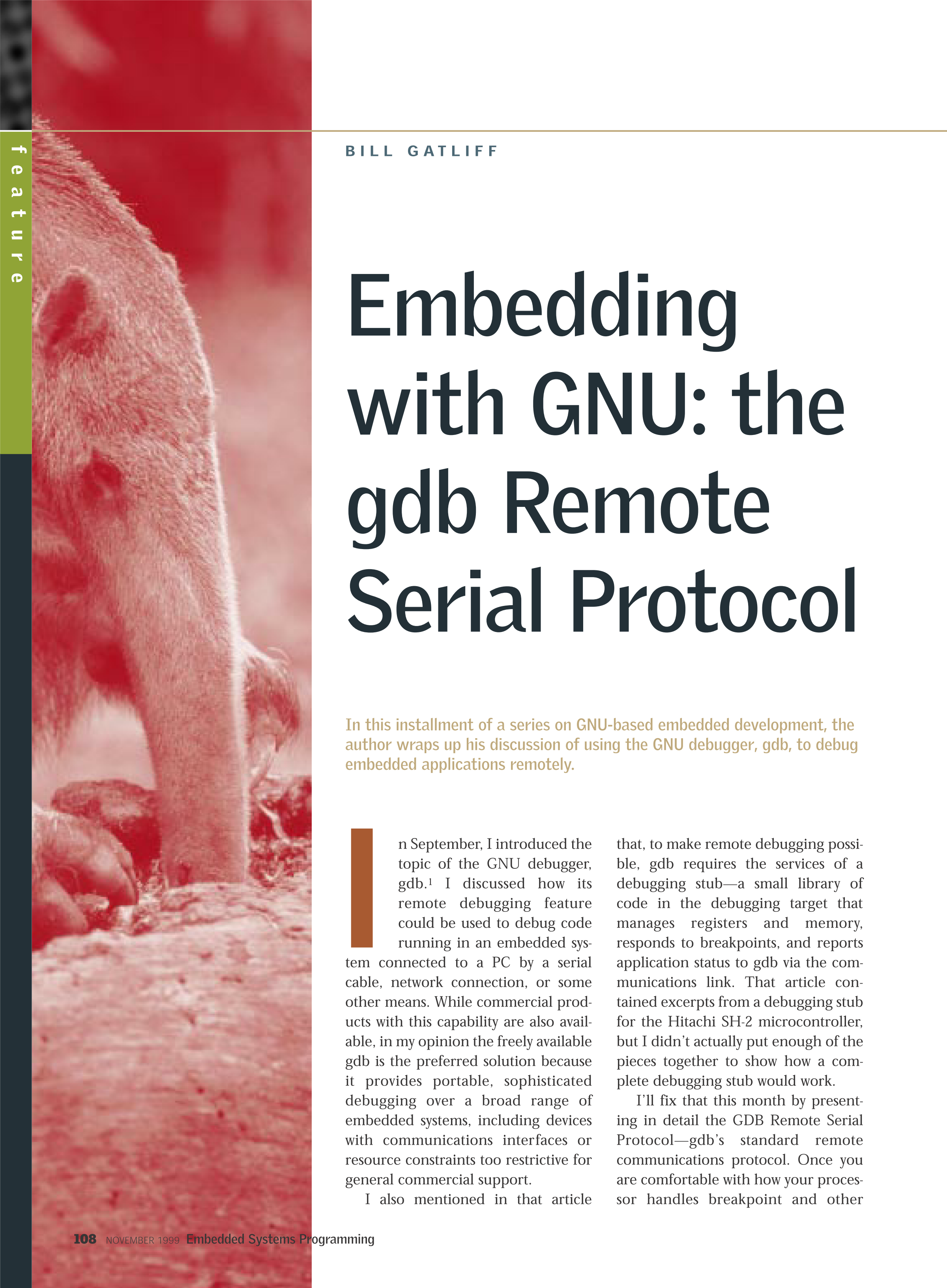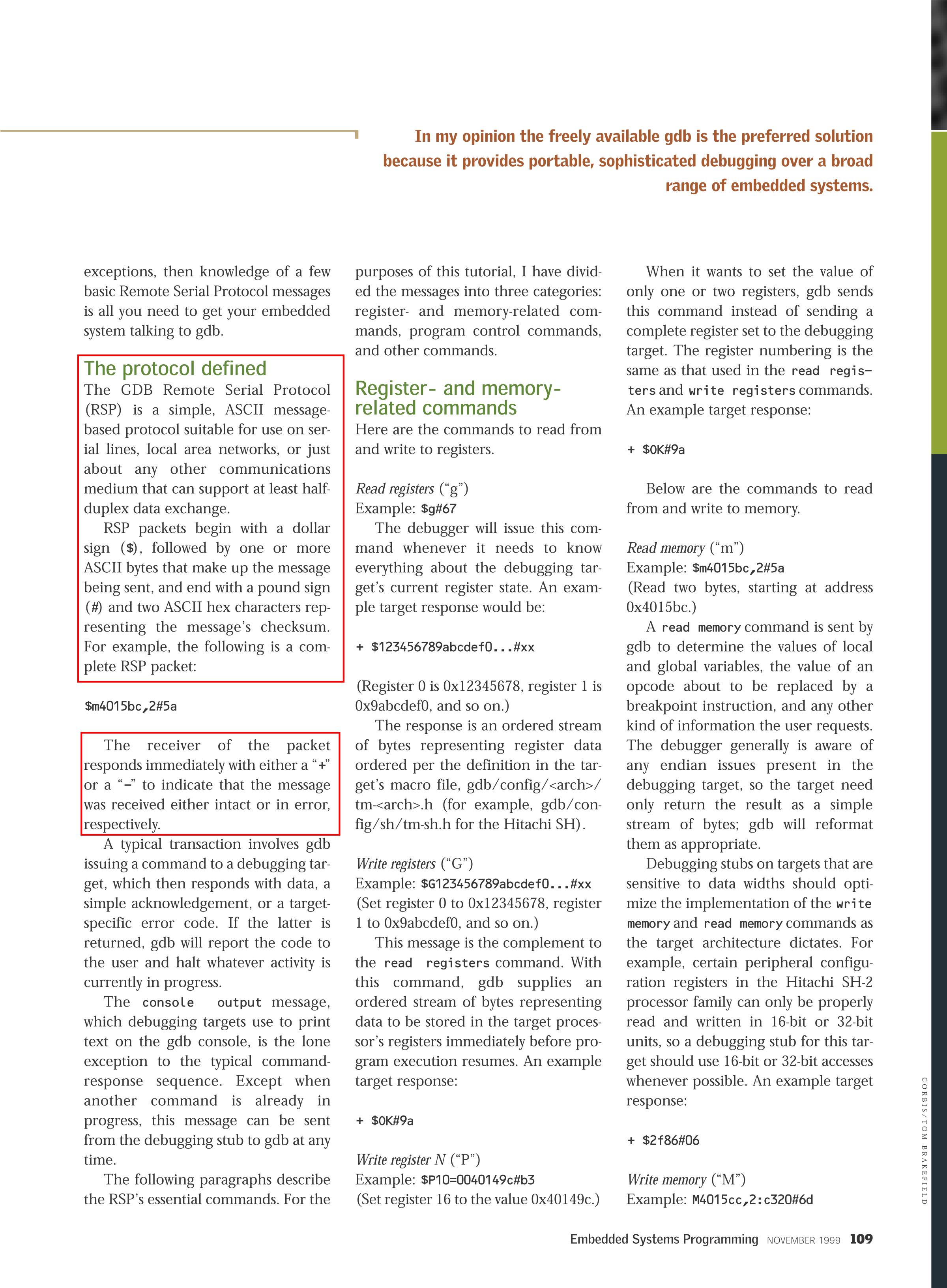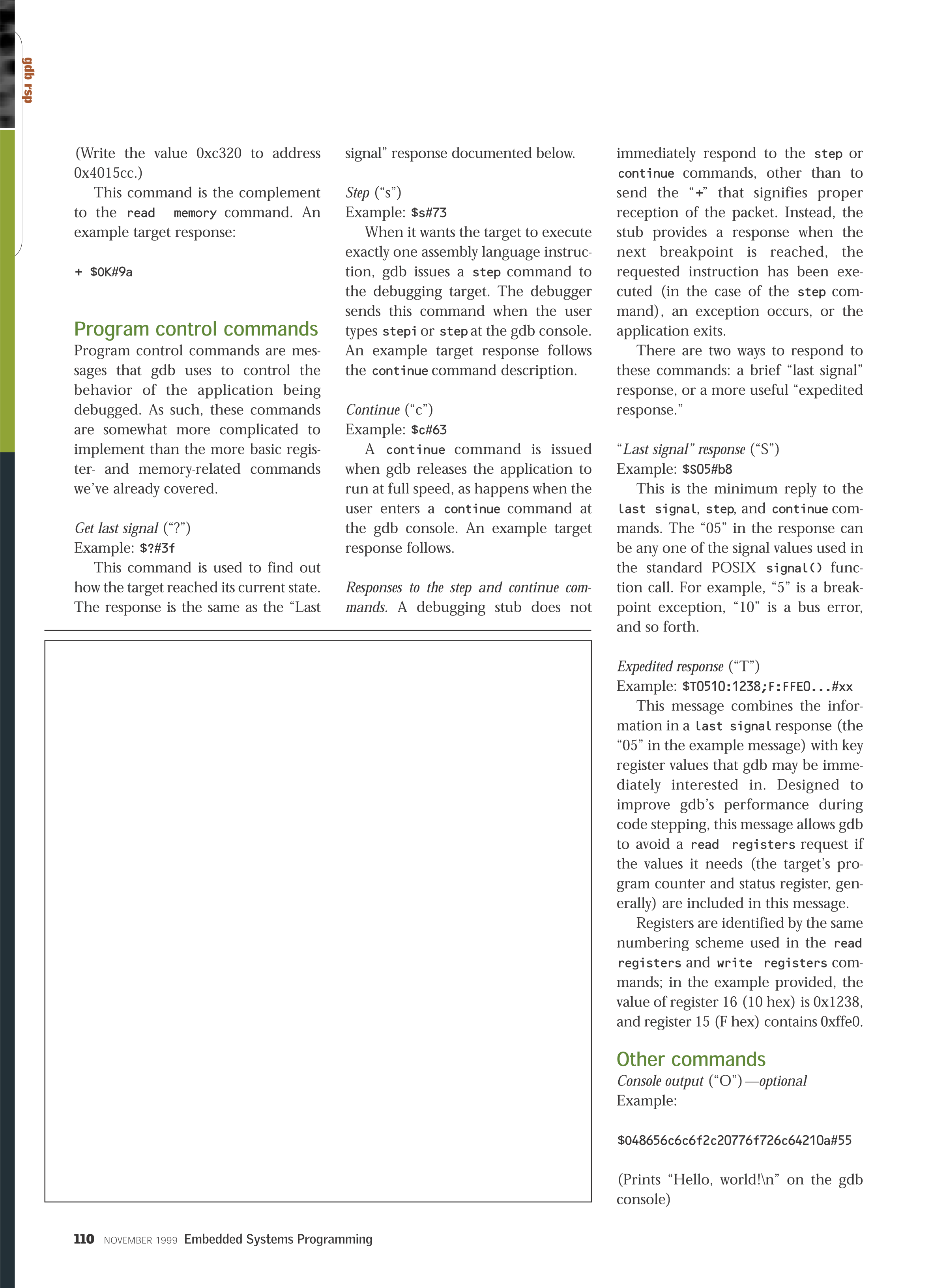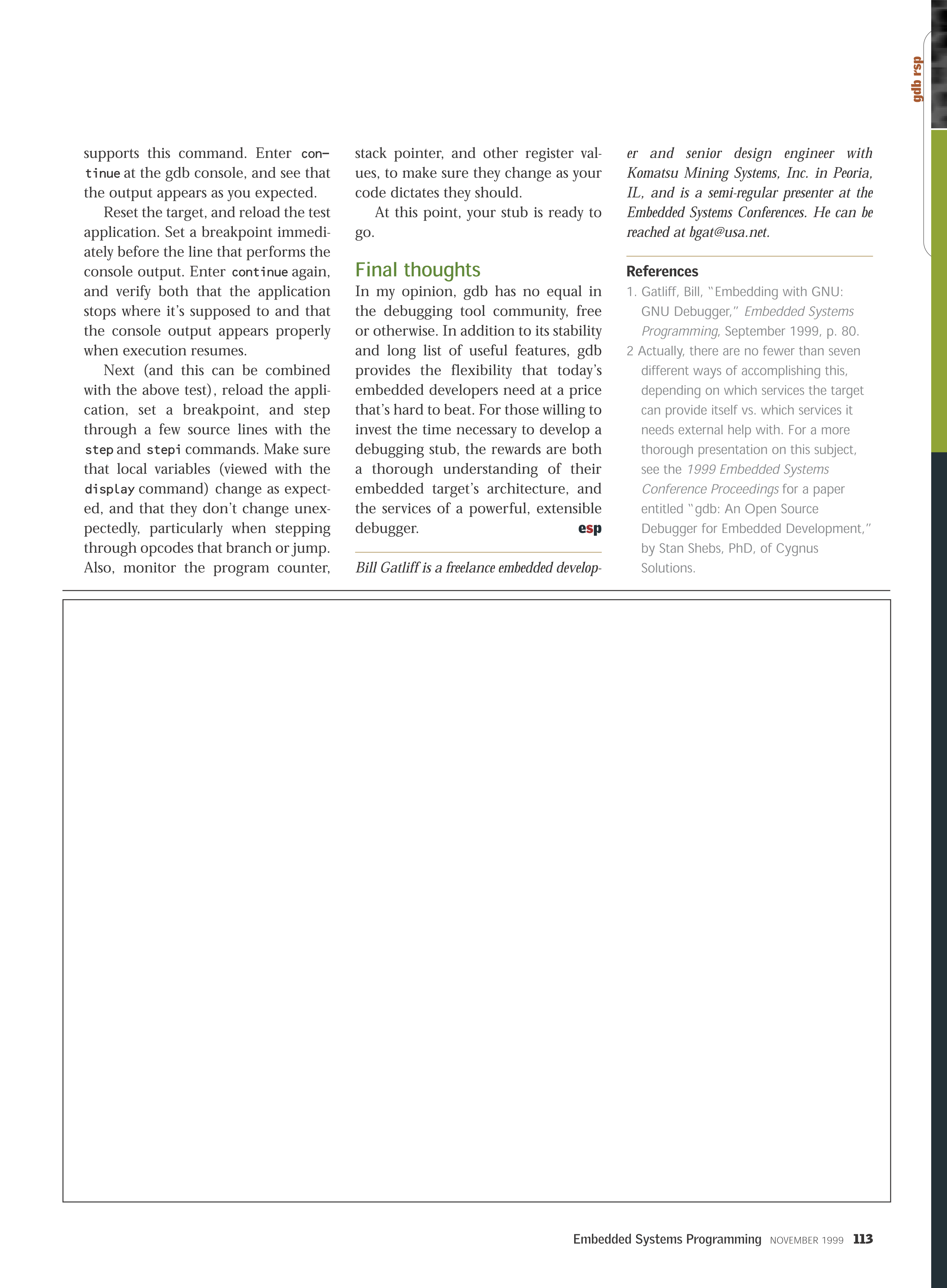





In September, I introduced the
topic of the GNU debugger,
gdb. 1 I discussed how its
remote debugging feature
could be used to debug code
running in an embedded sys-
tem connected to a PC by a serial
cable, network connection, or some
other means. While commercial prod-
ucts with this capability are also avail-
able, in my opinion the freely available
gdb is the preferred solution because
it provides portable, sophisticated
debugging over a broad range of
embedded systems, including devices
with communications interfaces or
resource constraints too restrictive for
general commercial support.
I also mentioned in that article
that, to make remote debugging possi-
ble, gdb requires the services of a
debugging stub—a small library of
code in the debugging target that
manages registers and memory,
responds to breakpoints, and reports
application status to gdb via the com-
munications link. That article con-
tained excerpts from a debugging stub
for the Hitachi SH-2 microcontroller,
but I didn’t actually put enough of the
pieces together to show how a com-
plete debugging stub would work.
I’ll fix that this month by present-
ing in detail the GDB Remote Serial
Protocol—gdb’s standard remote
communications protocol. Once you
are comfortable with how your proces-
sor handles breakpoint and other
108 NOVEMBER 1999 Embedded Systems Programming
B I L L G A T L I F F
f e a t u r e
Embedding
with GNU: the
gdb Remote
Serial Protocol
In this installment of a series on GNU-based embedded development, the
author wraps up his discussion of using the GNU debugger, gdb, to debug
embedded applications remotely.
I
Embedded Systems Programming NOVEMBER 1999 109
exceptions, then knowledge of a few
basic Remote Serial Protocol messages
is all you need to get your embedded
system talking to gdb.
The protocol defined
The GDB Remote Serial Protocol
(RSP) is a simple, ASCII message-
based protocol suitable for use on ser-
ial lines, local area networks, or just
about any other communications
medium that can support at least half-
duplex data exchange.
RSP packets begin with a dollar
sign ($), followed by one or more
ASCII bytes that make up the message
being sent, and end with a pound sign
(#) and two ASCII hex characters rep-
resenting the message’s checksum.
For example, the following is a com-
plete RSP packet:
$m4015bc,2#5a
The receiver of the packet
responds immediately with either a “+”
or a “-” to indicate that the message
was received either intact or in error,
respectively.
A typical transaction involves gdb
issuing a command to a debugging tar-
get, which then responds with data, a
simple acknowledgement, or a target-
specific error code. If the latter is
returned, gdb will report the code to
the user and halt whatever activity is
currently in progress.
The console output message,
which debugging targets use to print
text on the gdb console, is the lone
exception to the typical command-
response sequence. Except when
another command is already in
progress, this message can be sent
from the debugging stub to gdb at any
time.
The following paragraphs describe
the RSP’s essential commands. For the
purposes of this tutorial, I have divid-
ed the messages into three categories:
register- and memory-related com-
mands, program control commands,
and other commands.
Register- and memory-
related commands
Here are the commands to read from
and write to registers.
Read registers (“g”)
Example: $g#67
The debugger will issue this com-
mand whenever it needs to know
everything about the debugging tar-
get’s current register state. An exam-
ple target response would be:
+ $123456789abcdef0...#xx
(Register 0 is 0x12345678, register 1 is
0x9abcdef0, and so on.)
The response is an ordered stream
of bytes representing register data
ordered per the definition in the tar-
get’s macro file, gdb/config/<arch>/
tm-<arch>.h (for example, gdb/con-
fig/sh/tm-sh.h for the Hitachi SH).
Write registers (“G”)
Example: $G123456789abcdef0...#xx
(Set register 0 to 0x12345678, register
1 to 0x9abcdef0, and so on.)
This message is the complement to
the read registers command. With
this command, gdb supplies an
ordered stream of bytes representing
data to be stored in the target proces-
sor’s registers immediately before pro-
gram execution resumes. An example
target response:
+ $OK#9a
Write register N (“P”)
Example: $P10=0040149c#b3
(Set register 16 to the value 0x40149c.)
When it wants to set the value of
only one or two registers, gdb sends
this command instead of sending a
complete register set to the debugging
target. The register numbering is the
same as that used in the read regis-
ters and write registers commands.
An example target response:
+ $OK#9a
Below are the commands to read
from and write to memory.
Read memory (“m”)
Example: $m4015bc,2#5a
(Read two bytes, starting at address
0x4015bc.)
A read memory command is sent by
gdb to determine the values of local
and global variables, the value of an
opcode about to be replaced by a
breakpoint instruction, and any other
kind of information the user requests.
The debugger generally is aware of
any endian issues present in the
debugging target, so the target need
only return the result as a simple
stream of bytes; gdb will reformat
them as appropriate.
Debugging stubs on targets that are
sensitive to data widths should opti-
mize the implementation of the write
memory and read memory commands as
the target architecture dictates. For
example, certain peripheral configu-
ration registers in the Hitachi SH-2
processor family can only be properly
read and written in 16-bit or 32-bit
units, so a debugging stub for this tar-
get should use 16-bit or 32-bit accesses
whenever possible. An example target
response:
+ $2f86#06
Write memory (“M”)
Example: M4015cc,2:c320#6d
In my opinion the freely available gdb is the preferred solution
because it provides portable, sophisticated debugging over a broad
range of embedded systems.
C O R B I S / T O M B R A K E F I E L D
gdb rsp
(Write the value 0xc320 to address
0x4015cc.)
This command is the complement
to the read memory command. An
example target response:
+ $OK#9a
Program control commands
Program control commands are mes-
sages that gdb uses to control the
behavior of the application being
debugged. As such, these commands
are somewhat more complicated to
implement than the more basic regis-
ter- and memory-related commands
we’ve already covered.
Get last signal (“?”)
Example: $?#3f
This command is used to find out
how the target reached its current state.
The response is the same as the “Last
signal” response documented below.
Step (“s”)
Example: $s#73
When it wants the target to execute
exactly one assembly language instruc-
tion, gdb issues a step command to
the debugging target. The debugger
sends this command when the user
types stepior stepat the gdb console.
An example target response follows
the continue command description.
Continue (“c”)
Example: $c#63
A continue command is issued
when gdb releases the application to
run at full speed, as happens when the
user enters a continue command at
the gdb console. An example target
response follows.
Responses to the step and continue com-
mands. A debugging stub does not
immediately respond to the step or
continue commands, other than to
send the “+” that signifies proper
reception of the packet. Instead, the
stub provides a response when the
next breakpoint is reached, the
requested instruction has been exe-
cuted (in the case of the step com-
mand), an exception occurs, or the
application exits.
There are two ways to respond to
these commands: a brief “last signal”
response, or a more useful “expedited
response.”
“Last signal” response (“S”)
Example: $S05#b8
This is the minimum reply to the
last signal, step, and continue com-
mands. The “05” in the response can
be any one of the signal values used in
the standard POSIX signal() func-
tion call. For example, “5” is a break-
point exception, “10” is a bus error,
and so forth.
Expedited response (“T”)
Example: $T0510:1238;F:FFE0...#xx
This message combines the infor-
mation in a last signalresponse (the
“05” in the example message) with key
register values that gdb may be imme-
diately interested in. Designed to
improve gdb’s performance during
code stepping, this message allows gdb
to avoid a read registers request if
the values it needs (the target’s pro-
gram counter and status register, gen-
erally) are included in this message.
Registers are identified by the same
numbering scheme used in the read
registers and write registers com-
mands; in the example provided, the
value of register 16 (10 hex) is 0x1238,
and register 15 (F hex) contains 0xffe0.
Other commands
Console output (“O”)—optional
Example:
$O48656c6c6f2c20776f726c64210a#55
(Prints “Hello, world!\n” on the gdb
console)
110 NOVEMBER 1999 Embedded Systems Programming
gdb rsp
This command allows a debugging
stub to send a text message to the gdb
console. The text to be displayed is
sent in its hex byte equivalent (‘H’ ==
0x48) and gdb will queue successive
messages until it sees a newline (‘\n’,
0x0a) character.
This message always originates in
the debugging target; gdb never sends
a console output message to the
debugging target.
Empty response (“”)
If a debugging stub encounters a com-
mand it doesn’t support or under-
stand, it should return an empty
response. This allows gdb to select an
alternate command if one is available.
Example: <an unrecognized command>
Target response: + $#00
Error response (“E”)
When a debugging stub encounters an
error during command processing, it
should send an error response back to
gdb. Bus errors and/or illegal address-
es during memory operations are
examples of commands which may
generate an error response from a
debugging stub.
Example: <a command that produces
an error>
Target reponse: +$E01#xx
There aren’t any predefined error
codes in gdb; when gdb receives an
error message, it prints it on the con-
sole and halts the operation in
progress.
Putting it all together
At this point, I’ve covered individually
all the pieces necessary to get an
embedded system talking to gdb. In
the last article, I covered traps, single-
stepping, and a few gdb features; and
in the previous section I covered the
communications protocol that gdb
expects a debugging stub to use. All
we have left to do now is to throw all of
these pieces together, right?
Actually, we must deal with one
more minor consideration before
we’re really ready to start debugging
code: the chicken-and-egg problem of
actually getting the debugging stub
into the embedded system for the first
time, so that gdb has something with
which to communicate when we turn
on the power.
Several methods of attacking this
problem exist. 2 To me, the best way
always seems to be to place a minimal
stub into some kind of nonvolatile
memory in the target, and use that
code to both boot the system and help
gdb download the rest of the applica-
tion into RAM. Once gdb starts the
application, debugging control then
transfers to a second debugging stub
linked with the application itself.
Embedded Systems Programming NOVEMBER 1999 111
gdb rsp
The biggest advantage of this
approach is that it allows you to con-
tinue developing the application-
linked debugging stub without need-
ing to reprogram the resident stub in
the target’s nonvolatile memory,
which is a real bonus if the only non-
volatile memory available is one-time-
programmable ROM. Furthermore,
because the resident stub needs to
know only the simplest commands—
read memory, write memory, write
register N, and continue—the likeli-
hood of a serious bug being present in
this code is fairly low.
Another approach is to place a
complete debugging stub into the tar-
get’s nonvolatile memory, and use it
for all debugging activities. This elimi-
nates the need to link a debugging
stub with the target application, but
may make it more difficult to change
the stub if errors are found or new fea-
tures are added.
If you’re using a commercial micro-
processor evaluation board, you might
not need to provide a debugging stub
at all—gdb may already support the
vendor’s protocol, or you may be able
to add support to gdb after spending a
few minutes reverse-engineering the
protocol with a serial-port analyzer.
Check the vendor’s license agreement
if you take this approach: you may
need to sign a non-disclosure agree-
ment first, and you will definitely need
to seek permission before releasing
your gdb improvements to the com-
munity at large.
Testing a debugging stub
Once you think you have a debugging
stub ready to go, you’ll want to test it
as thoroughly as possible before
putting it to work. Remember, the
only thing worse than a buggy applica-
tion is a buggy development tool.
The following is a test procedure I
recommend you use whenever you
make changes to your debugging stub,
to make sure things are working the
way they should.
First, for convenience, add the fol-
lowing lines to your .gdbinit file:
set remotedebug 1
set remotelogfile gdb_logfile
These commands make gdb display all
RSP messages exchanged between the
host and the target, as well as log them
to the file gdb_logfile.
Next, connect gdb to the remote
target, and enter the target remote
[port] command. As gdb makes the
connection, watch the messages
exchanged to make sure that your stub
provides the proper responses to gdb’s
requests.
During startup, your debugging
stub should load values into each of
the target processor’s registers. Use
gdb’s info registers command to
confirm that gdb can properly receive
and display these values.
Next, use gdb’s set command to
change a few register values, and make
sure that the stub both properly
responds to gdb’s write register
command, and returns the correct
results in subsequent read registers
commands initiated when you type
info registers.
Next, do the same thing for a few
memory locations—have the stub set
the locations at startup, and then veri-
fy that gdb can read and write these
locations on request. For example, try
the following:
print *(long*)0x1234
set *(long*)0x1234=5678
print *(long*)0x1234
If everything works so far, you’re
ready to try out gdb’s load command.
The console will get extremely noisy as
gdb displays the multitude of write
memory commands it uses to transfer a
test application to the target. You’ll
want to refer to the log file then, to
ensure that everything happened as
expected. Once this has been com-
pleted, check a few memory locations
in the application’s code space to con-
firm that the expected values are
there.
The test application should contain
some gdb console output if your stub
112 NOVEMBER 1999 Embedded Systems Programming
gdb rsp
supports this command. Enter con-
tinue at the gdb console, and see that
the output appears as you expected.
Reset the target, and reload the test
application. Set a breakpoint immedi-
ately before the line that performs the
console output. Enter continue again,
and verify both that the application
stops where it’s supposed to and that
the console output appears properly
when execution resumes.
Next (and this can be combined
with the above test), reload the appli-
cation, set a breakpoint, and step
through a few source lines with the
step and stepi commands. Make sure
that local variables (viewed with the
display command) change as expect-
ed, and that they don’t change unex-
pectedly, particularly when stepping
through opcodes that branch or jump.
Also, monitor the program counter,
stack pointer, and other register val-
ues, to make sure they change as your
code dictates they should.
At this point, your stub is ready to
go.
Final thoughts
In my opinion, gdb has no equal in
the debugging tool community, free
or otherwise. In addition to its stability
and long list of useful features, gdb
provides the flexibility that today’s
embedded developers need at a price
that’s hard to beat. For those willing to
invest the time necessary to develop a
debugging stub, the rewards are both
a thorough understanding of their
embedded target’s architecture, and
the services of a powerful, extensible
debugger. esp
Bill Gatliff is a freelance embedded develop-
er and senior design engineer with
Komatsu Mining Systems, Inc. in Peoria,
IL, and is a semi-regular presenter at the
Embedded Systems Conferences. He can be
reached at bgat@usa.net.
References
1. Gatliff, Bill, “Embedding with GNU:
GNU Debugger,” Embedded Systems
Programming, September 1999, p. 80.
2 Actually, there are no fewer than seven
different ways of accomplishing this,
depending on which services the target
can provide itself vs. which services it
needs external help with. For a more
thorough presentation on this subject,
see the 1999 Embedded Systems
Conference Proceedings for a paper
entitled “gdb: An Open Source
Debugger for Embedded Development,”
by Stan Shebs, PhD, of Cygnus
Solutions.
Embedded Systems Programming NOVEMBER 1999 113